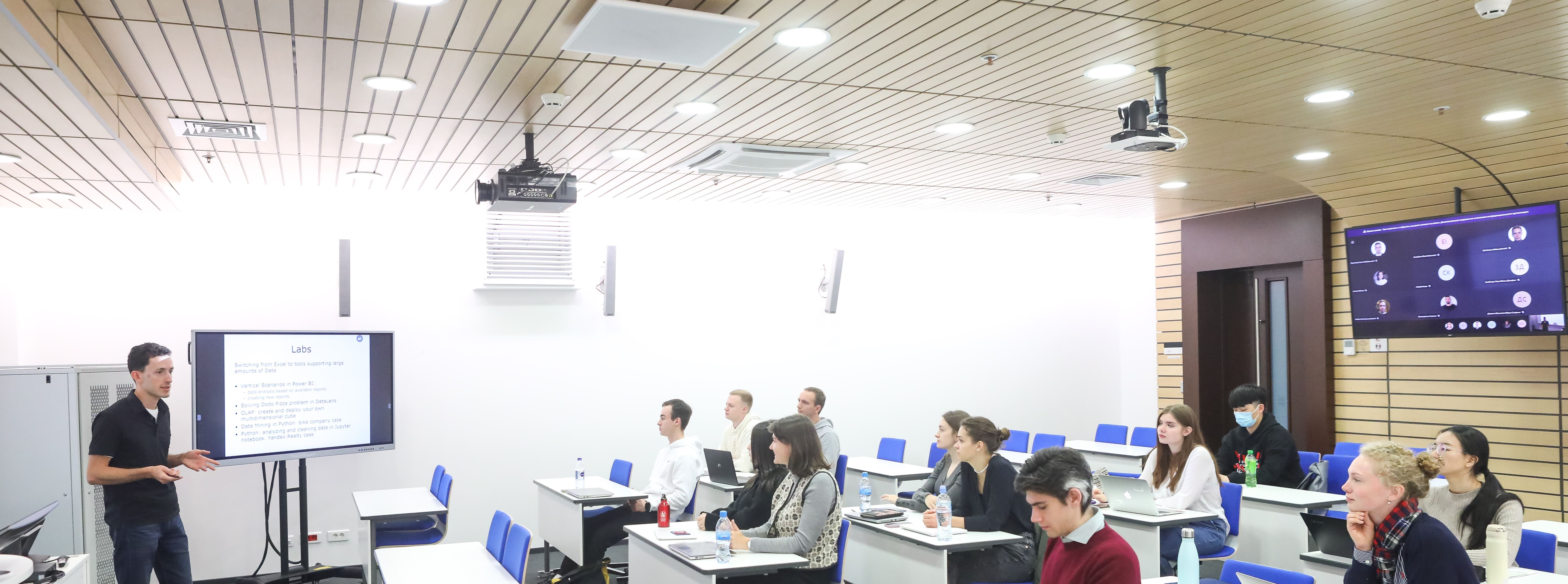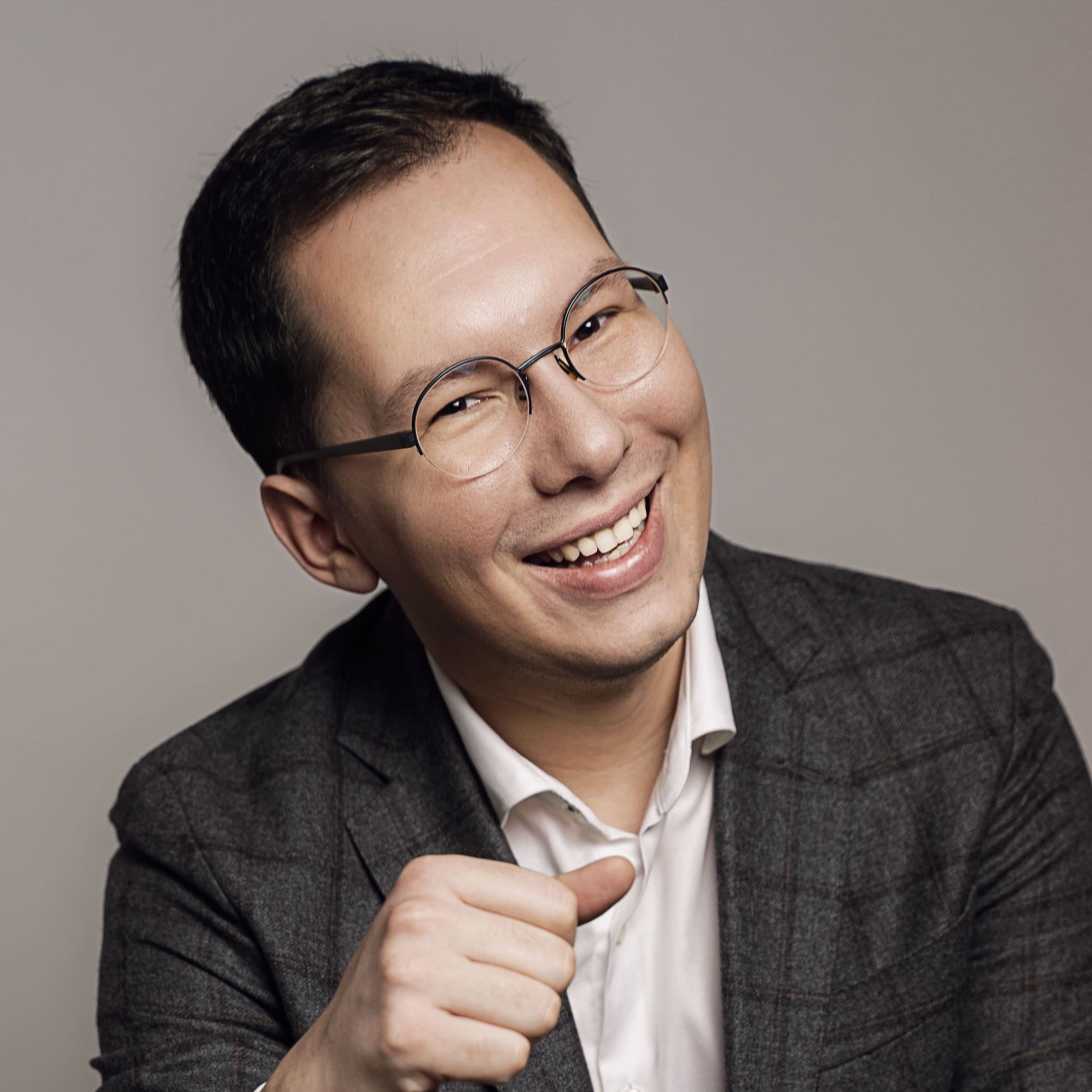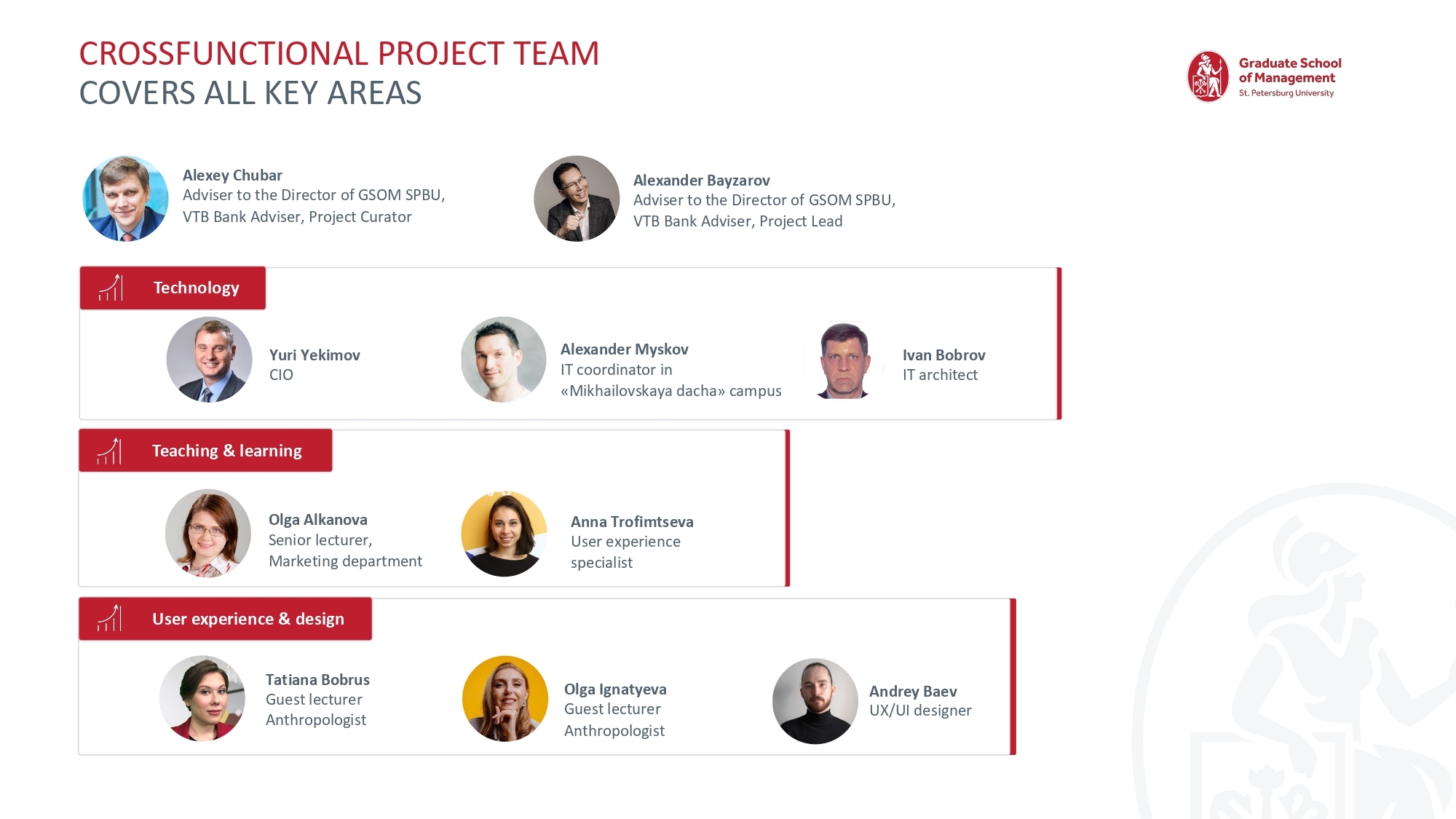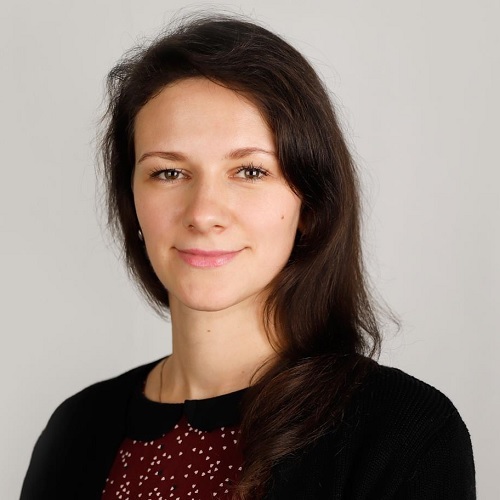11 October 2021
One of the key events for the Graduate School of Management of St. Petersburg University (GSOM SPbU) was creating a hybrid learning format last year. The business school has found such a successful response to the pandemic challenge that it is now being introduced into everyday "peaceful" practice. How was it? Here we call on the participants of the HYBRID LEARNING project.
When GSOM SPbU switched to remote learning at the start of the pandemic in March 2020, the business school faced not only the organizational and technical challenge of transferring studies to an online format but even more difficult was adapting content to new delivery methods.
The COVID practice of distance learning quickly made it possible to verify the effectiveness of many online teaching tools — it became obvious that they could also be used in offline classes with the same success, increasing student engagement and the quality of the learning experience.
In addition, the situation threatened to drag out — and it prolonged. Online life deprived faculty and students of an essential component — the campus experience. It was necessary to gradually return to offline studies, but many foreign and nonresident students still could not arrive in St. Petersburg. So, a new format was required that combined offline and online students.

Photo spbdnevnik.ru
The business school needed a comprehensive solution that allowed them to "combine" the professor — in the classroom, some of the students — also in the classroom, and the others - synchronously on a remote connection. To do this, it was necessary to create:
The authors of the idea decided the hybrid should meet several requirements: to ensure seamless educational experience for students regardless of their location, to become a technically simple and understandable set of tools for faculty, and, importantly, to be economically justified both in production and in operation.
After the first attempts to bring hybrid to GSOM SPbU, it became obvious: hybrid learning can grow into a full-fledged form of education with appropriate methodology and instructional design. Investments in the development of such a form of education will be justified even after the end of the pandemic. It will allow creation of entirely new programs that are not tied to a physical location while preserving the possibility of campus experience.
The project was implemented in the shortest possible time. Two reliable and repeatedly tested hybrid classrooms at the Mikhailovskaya Dacha campus were ready for operation by the summer of 2021. A cross-functional team of IT specialists, methodologists, anthropologists and designers worked on the pilot solution. It was based on the methodology of design thinking.
Big plans ahead: the tested solution is easier to implement. It will be used for building new hybrid classrooms in the Mikhailovskaya Dacha campus: by the next academic year, ten more hybrid classrooms should be set up. Two hybrid classrooms are also planned for 2022 in GSOM SPbU downtown campus in Volkhovsky Lane.
In the 2021/2022 academic year, GSOM SPbU is testing this new solution in regular course settings – to improve the methodology and user experience.
The first attempt to solve the problem of hybrid learning was made in November 2020. We equipped two classrooms in our downtown campus with video conferencing equipment. But the solution "did not fly."
The key problem turned out to be our narrow-minded approach to the problem: from the very beginning, we structured our work only in terms of the classroom — the physical space but did not consider the task from a higher level. A more comprehensive approach would have consisted of creating hybrid learning as a bunch of methodology and IT infrastructure.
Even though hybrid classrooms were set up and looked stable, it did not help us reach our learning goals. These goals turned out to be far more complex than holding sessions meetings in video conferencing rooms.
At that time we did not design, test, or implement the learning methodology for hybrid and did not train our faculty. In fact, after creating the classroom, the professor was left alone with an imperfect and unfamiliar technology, the use of which was not always obvious.
We have learned our lessons from this "zero attempt":
Senior Lecturer of the GSOM SPbU Marketing Department, Head of Hybrid Learning Methodology Olga Alkanova explains:


The educational process is always a matter of methodology first, and only then the tools that allow it to be implemented. At the same time, the environment where this process takes place is more than a set of tools. In our case, the task was to combine two environments — offline and online - in a single educational space not sequentially but simultaneously, and such a hybrid environment sets its own rules of the game. When students are in two different environments, the methodology of the course construction solves the problem of forming a unified educational experience for both.
Both training formats have their advantages and limitations. Since the pandemic's beginning, experiments in synchronous online learning have shown that not all the techniques and solutions of the regular offline classes are applicable in a digital environment, and building a course in online mode requires a revision of the methodology compared to the usual approaches.
But the hybrid format is not the result of arithmetic operations with two methodologies. Based on the experience of the first test sessions with GSOM SPbU faculty, we were convinced that special training, adaptation of courses to the new specifics of communication, control of information assimilation is essential for their work in a mixed format. The instructional design of the courses should consider equal educational opportunities for students online and offline, allow stimulating the involvement and interaction of the two groups, which entails revision of the lesson scenario, choice of digital tools and task options, development of the habit of the professor to work equally with both groups of students at the same time.
At the same time, the discipline of behavior is vital for students (for example, mandatory participation with the camera turned on), including creating the very effect of full presence that we are seeking. And including these rules of the game explicitly in the "learning contract" with students contributes to improving the experience of the hybrid process for all participants."

Creation of a seamless educational environment, taking into account all the needs of faculty, students in the classroom, and students in the online space, where users would not stumble over the technology — autonomous and does not require support by a specially trained IT team. This is how the authors of the idea of hybrid learning formulated their goal after their first attempt to launch the hybrid at GSOM SPbU - it was undertaken in November 2020 and was not successful (ATTEMPT # 0).
Alexander Bayzarov, Head of the Hybrid Learning Project, Advisor at VTB Bank, says:


The demand for fully functioning hybrid learning solutions continued to expand. Uncertainty due to COVID restrictions made it impossible to predict return to offline learning, and attempts to "broadcast lectures" for those who could not come to campus were not perfect to say the least.
At the same time, surveys on the quality of distance learning at GSOM SPbU showed the growing fatigue of students from online learning. Many students wanted to return to live communication with classmates and faculty in the atmosphere of the Mikhailovskaya Dacha campus.
The critical question at this stage was how to provide comparable (or better) educational experience and educational outcomes for students regardless of their location? The hypothesis was that a technologically well-equipped space (which reflected the peculiarities of the educational process), coupled with the teaching methodology, was the key to the problem.
The analysis showed no ready-made solutions on the market that could simply be bought and installed in a university. It was a challenge for us - and an opportunity to create a fundamentally new product. "
GSOM SPbU assembled a cross-functional team of IT specialists, professors and methodologists, anthropologists, and designers to solve the problem. Design thinking was chosen as a product development methodology. At various stages in the process, faculty and students of the Business school were involved.

|
Experts in design thinking methodology played a unique role in the team working on the hybrid learning solution. Their teammates on the project call them anthropologists - in fact, specialists who study humanity as a species. What specifics did they have to take into account? |


"Building classrooms for hybrid learning is one of the elements of a full-fledged digital educational environment (DEE). Converting the entire educational process into digital and building additional digital services is one of the strategic goals of GSOM SPbU. The business school is a testing ground for the development of modern digital technologies in education as part of the development strategy of St. Petersburg State University. Our experience, if successful, will be replicated throughout the university," says Yury Ekimov, CIO of GSOM SPbU.
He explains: "The key to success is flexibility and convenience for all participants in the educational process. The main scenarios programmed for the audience are displayed on the controlled display as small, ergonomically friendly screens, clicking on which launches all the programmed "underneath" capabilities. The format allows for the option of communication between two or even several hybrid audiences. The number of professors can be more than two, and the number of students is almost unlimited. All this dramatically diversifies the tools for conducting educational activities and solves the problem of expanding the audience and the faculty. It is also convenient that a student who was present at the lesson - or could not do it - can always revise, "turn over" in the record what was told, since each lesson or lecture is uploaded to the cloud.
IT coordinator at the Mikhailovskaya Dacha campus, Alexander Myshkov, lists the technical equipment of the premises:

Hybrid classrooms’ architecture reflects all modern trends in the creation of "smart classrooms." A camera with auto-tracking, a microphone array, a unified control system based on learning scenarios. The professor can adjust the sound amplification using the control panel, close and open doors, and change the lighting options. The audience also has a document camera for broadcasting materials from paper, an interactive whiteboard that replaces a flipchart, and TV panels with online participants. "

"The key elements of any learning scenario are video and sound. There is only one intelligent microphone array in the auditorium hanging on the ceiling for the entire room. In the process, we got rid of all wearable radio microphones, wired microphones, with which we always have problems - either the batteries run out, or they are forgotten to turn on. But in the end - perfect audibility at any point in the audience. As in the theater. Here I must say that we were lucky: the classrooms were well-designed in terms of acoustics; this was thought out during the construction of our campus" — Yury Ekimov.
Interestingly, the microphone array, which captures sound from anywhere in the classroom, has its specifics: due to its sensitivity students and professors can be deprived of privacy during breaks, participants in the online environment hear their conversations. A special pause mode is used to cope with this problem; all microphones are muted when pause mode is activated.

"The visual part: one camera is watching the professor, the second is watching the audience itself. We also had to consider what information and in what form to display on screens in front of in-class students, on television panels, which are located behind the back of the professor, on a mobile interactive board on the side for teamwork in the learning process in a hybrid format", — Yuri Ekimov.
Andrey Baev, a designer, explains:

From the interface point of view, a hybrid classroom is essentially a large "smart home" with dozens of different devices, each of which has its own, and sometimes quite complex, settings. A hybrid room speaker can control all devices from a small tablet at the lecturer's desk, and our goal was to create a convenient and user-friendly UI (User Interface).
Our approach was based on the user-centered design, focusing on the needs and expectations of a hybrid room speaker, our user. Empathy for the user meant for us taking into account technical characteristics of the equipment as well as the physical environment (light, interior of the room) and psychological and behavioral aspects of teaching in a hybrid classroom. Since new, technically complex systems are inevitably associated with stress and increased mental load for the speaker, with the interface, we aimed for the user's maximum peace of mind and confidence in the system. This is why we used design metaphors and navigation mechanisms which are already familiar to users through the use of personal gadgets and other digital devices. With UX writing, when composing messages, instructions, and system tooltips, we paid particular attention to the tone of communication. We adhered to neutral and unambiguous formulations without bureaucratic language and jargon.
When designing the UI, we thought not just about the features of the system, but ultimately, the user's goals. For example, we deliberately do not allow a lecturer to control lighting elements in the audience separately, while at the same time we include an option to quickly dim the front section of the room's lights to show students a video through the projectors more comfortably. This approach allowed us to avoid interface overload. The resulting UI is intuitive and straightforward, and allows to start using the system without reading the manuals. And when a hybrid session is started, the control panel does not require any additional attention to itself.
The hybrid room management system turned out to be universal: it supports two languages, two modes of conducting classes (hybrid and offline), and several dozen different equipment configurations. The work on the interface was truly in-depth: based on the insights received from the methodologists, we considered over a hundred different user flows. Among other things, we have thought of atypical usage scenarios, designed timely prompts in the system interface, and laid down the logic that predicts further user actions and overall makes the use of the system even more effective. "

"I love new technologies in teaching, and I was even glad to start teaching in online mode. It became possible to introduce exciting new tools for conveying information to the audience: interactive whiteboards and common spaces for work. In the face-to-face classes, unfortunately, it was not possible to use many online tools. However, we all know about the disadvantages of online interactions: it is simply impossible to form some skills without personal interaction.
From my point of view, the main advantage of the hybrid format is the convenience of combining excellent online tools and face-to-face format. It allows you to supplement the face-to-face format with interesting engagement tools and diversify the educational process.
The hybrid interface is convenient and simple from the user's point of view, I would say it is intuitive. This is important: after all, the professor’s biggest fear associated with technical advances is that they will have to keep in mind even more information, control not only students, but also monitor the equipment, blackboard, projector, and bell at the same time. The interface of the hybrid audience removes this fear." — Anastasia Laskovaya, Academic Director of the Bachelor in Management Program, Associate Professor of the Department of Strategic and International Management, GSOM SPbU.
![]()

"The hybrid format of GSOM SPbU is a cool idea. I am glad that we have such an opportunity. The MS Teams platform makes this format convenient: the camera monitors the professor’s movement, and the students interact with her/him through the gadget screen, feeling an in-person presence, and also see the participants - both in the classroom and remotely" — Anastasia Nikonova, a third-year student of the Management program. "
![]()
 "Working in a hybrid classroom is very similar to the usual live activity, but with enhanced capabilities due to technological equipment. This is a full-fledged face-to-face communication with students since their feedback is established regardless of where they are. It is enough just to look at the faces. There is no need to ask to turn on the cameras specifically. The main thing is not to forget to include everyone in the discussion from time to time. Therefore, the experience of students in the classroom and those who connect from the outside is practically the same, and the teaching experience is richer compared to the online mode. In addition, being present in-class in a hybrid classroom, students can have additional informal communication with other students and the teacher. So, learning becomes much more efficient. The high quality of video and audio broadcasting is noteworthy. Since the camera accompanies the professor wherever he goes, special microphones suppress unnecessary noise and make the lecturer's speech clearer, and students have a sense of presence. This is a completely different quality of teaching compared to online when teachers are usually forced to use ordinary laptops with standard cameras." — Alexander Andrianov, Co-director of the Master in Corporate Finance (MCF) program, senior lecturer in the Department of Finance and Accounting.
"Working in a hybrid classroom is very similar to the usual live activity, but with enhanced capabilities due to technological equipment. This is a full-fledged face-to-face communication with students since their feedback is established regardless of where they are. It is enough just to look at the faces. There is no need to ask to turn on the cameras specifically. The main thing is not to forget to include everyone in the discussion from time to time. Therefore, the experience of students in the classroom and those who connect from the outside is practically the same, and the teaching experience is richer compared to the online mode. In addition, being present in-class in a hybrid classroom, students can have additional informal communication with other students and the teacher. So, learning becomes much more efficient. The high quality of video and audio broadcasting is noteworthy. Since the camera accompanies the professor wherever he goes, special microphones suppress unnecessary noise and make the lecturer's speech clearer, and students have a sense of presence. This is a completely different quality of teaching compared to online when teachers are usually forced to use ordinary laptops with standard cameras." — Alexander Andrianov, Co-director of the Master in Corporate Finance (MCF) program, senior lecturer in the Department of Finance and Accounting.
![]()
Video: PR of the Governor of St. Petersburg
The final stage in implementing the hybrid training format at GSOM SPbU was the training of faculty and the adaptation of the course content to the new reality.
Personal support of the faculty members, pilot classes in peer-to-peer format, consultations on instructional design allow quick and efficient implementation of new technology into everyday practice.
Anna Trofimtseva, the User Experience Specialist, shares the details:

In preparation for working in hybrid classrooms, we are conducting two face-to-face classes for the faculty of GSOM SPbU at the Mikhailovskaya Dacha campus. The first is devoted to getting to know the hybrid classroom: we explain how, from a technical point of view, organize and conduct a lesson in a new space, methodologically adapt the training course to a hybrid. Professors can get hands-on experience: press all the buttons themselves, start the class, ask questions. After that, everyone gets their homework: to master the technical features of the format, prepare the class thoroughly - from planning to conducting. The second face-to-face lesson is devoted to demonstrating the results in peer-to-peer format and the individual analysis of each professor’s homework.
Everyone can receive an individual consultation on the methodology and specifics of adapting their courses to the hybrid format. If necessary, professors have the opportunity to conduct a debut lesson for themselves together with an assistant or test the hybrid classroom again. "
Today, the team continues to work on the project in three main areas: introducing hybrid learning into the educational programs of GSOM SPbU, typifying teaching methodology and technological solutions, and disseminating experience to other universities and educational organizations.
Alexander Bayzarov, Head of the Hybrid Learning Project, Advisor at VTB Bank, summarizes the interim results and outlines the prospects:


"For the fall semester 2021/22, the team plans to train 100% of GSOM SPbU faculty in teaching methodology in a hybrid format. Some of the Bachelor's and Master's courses are already being implemented using this format.
In parallel, the team continues to test and optimize the methodology and technological solution for training in a hybrid format and plan to research the quality of user and educational experiences.
Today we can say that hybrid education is becoming one of the methodological innovations of GSOM SPbU in business education. We will continue to invest in its development and will soon invite all interested partners to join the process".
При использовании данного сайта Вы подтверждаете свое согласие на использование ВШМ СПбГУ cookie файлов. С подробной информацией Вы можете ознакомиться, перейдя по ссылке.